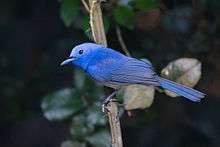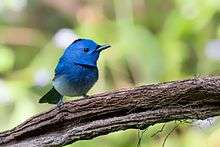Black-naped monarch
| Black-naped monarch | |
|---|---|
 | |
| A male (H. a. montana) from Kaeng Krachan in Thailand. | |
.jpg) | |
| H. a. montana female | |
| Scientific classification | |
| Kingdom: | Animalia |
| Phylum: | Chordata |
| Class: | Aves |
| Order: | Passeriformes |
| Family: | Monarchidae |
| Genus: | Hypothymis |
| Species: | H. azurea |
| Binomial name | |
| Hypothymis azurea (Boddaert, 1783) | |
| Subspecies | |
|
See text | |
| approximate distribution | |
| Synonyms | |
| |
The black-naped monarch or black-naped blue flycatcher (Hypothymis azurea) is a slim and agile passerine bird belonging to the family of monarch flycatchers found in southern and south-eastern Asia. They are sexually dimorphic, with the male having a distinctive black patch on the back of the head and a narrow black half collar ("necklace"), while the female is duller with olive brown wings and lacking the black markings on the head. They have a call that is similar to that of the Asian paradise flycatcher, and in tropical forest habitats, pairs may join mixed-species foraging flocks. Populations differ slightly in plumage colour and sizes.
Taxonomy and systematics

The black-naped monarch was originally described in the genus Muscicapa, and some authorities have also classified it in the genus Monarcha. Alternate names for the black-naped monarch include black-naped blue monarch and black-naped monarch flycatcher. Some authorities separate two former subspecies, H. a. blasii (Banggai Island) and H. a. puella (Sulawesi), and place them as subspecies of the pale-blue monarch (Hypothymis puella).[2]
Subspecies
Twenty-three subspecies are recognized:[3]
- Indian black-naped blue monarch (H. a. styani) - (Hartlaub, 1899): Originally described as a separate species in the genus Ficedula, found from India and Nepal to southeast China and Vietnam. The abdomen is whitish in males.
- H. a. oberholseri - Stresemann, 1913: Found in Taiwan
- H. a. ceylonensis - Sharpe, 1879: Originally described as a separate species, found in Sri Lanka. The males lack the black necklace.
- Andamanen black-naped blue monarch (H. a. tytleri) - (Beavan, 1867): Originally described as a separate species in the genus Myiagra. Found in the Andaman Islands. The abdomen of males is blue.
- H. a. idiochroa - Oberholser, 1911: Found on Car Nicobar (northern Nicobar Islands). The abdomen of males is white tinged with blue.
- H. a. nicobarica - Bianchi, 1907: Found on southern Nicobar Islands. The abdomen of males is white tinged with blue.
- H. a. montana - Riley, 1929: Found in northern and central Thailand
- H. a. galerita - (Deignan, 1956), 1929: Found in southwest and southeast Thailand
- H. a. forrestia - Oberholser, 1911: Found in Mergui Archipelago (off western Myanmar)
- H. a. prophata - Oberholser, 1911: Found on Malay Peninsula, Sumatra and Borneo
- H. a. javana - Chasen & Kloss, 1929: Found on Java and Bali (Indonesia)
- H. a. penidae - Meise, 1942: Found on Nusa Penida (near Bali in the Lesser Sundas)
- H. a. karimatensis - Chasen & Kloss, 1932: Found on Karimata Island (off western Borneo)
- H. a. opisthocyanea - Oberholser, 1911: Found on Anambas Islands (in the South China Sea)
- H. a. gigantoptera - Oberholser, 1911: Found on Natuna Besar (Natuna Islands, South China Sea)
- H. a. consobrina - Richmond, 1902: Originally described as a separate species, found on Simeulue (off north-western Sumatra)
- H. a. leucophila - Oberholser, 1911: Found on Siberut (off western Sumatra)
- H. a. richmondi - Oberholser, 1911: Found on Enggano Island (off south-western Sumatra)
- H. a. abbotti - Richmond, 1902: Originally described as a separate species, found on Reusam and Babi Islands (off north-western Sumatra)
- H. a. symmixta - Stresemann, 1913: Found on western and central Lesser Sundas
- Philippine black-naped monarch (H. a. azurea) - (Boddaert, 1783): Also known as the black-capped monarch and Philippine black-naped blue monarch. Found in Philippines (except Camiguin Sur Island)
- H. a. aeria - Bangs & Peters, JL, 1927: Originally described as a separate species, found on Maratua Island (off eastern Borneo)
- H. a. catarmanensis - Rand & Rabor, 1969: Found on Camiguin Sur Island (southern Philippines)
Description
.jpg)
The adult male black-naped monarch is about 16 cm long, and is mainly pale azure blue apart from a whitish lower belly. It has a black nape and a narrow black gorget. The female is duller and lacks the black markings. Its wings and back are grey-brown. However, several geographically separated breeding populations differ in the extent and shade of markings. The Indian peninsula has subspecies H. a. styani (which subsumes H. a. sykesi of Stuart Baker[4]), in which males have very distinct black markings and a whitish abdomen. Males of the Sri Lankan race H. a. ceylonensis lack the black nape and gorget and the shade is more purplish. The subspecies of the Andaman Islands, H. a. tytleri, has the underparts blue grey. The form on Car Nicobar Island, H. a. idiochroa, has a greyish white belly, while H. a. nicobarica from the southern Nicobars has a smaller and finer bill.[5][6] The colour of the gape is yellowish to green.[7]
Distribution and habitat
The black-naped monarch breeds across tropical southern Asia from India and Sri Lanka east to Indonesia and the Philippines. This species is usually found in thick forests and other well-wooded habitats.
The calls are a sharp and abrupt skrip.[5] The main breeding season in India is in summer from May to July. Two to three eggs are laid in a cup nest placed in the fork of a tree. The nest is decorated with spider-egg cases.[8]
Behaviour and ecology
The black-naped monarch has short legs and sits very upright whilst perched prominently, like a shrike. It is insectivorous, often hunting by flycatching. When alarmed or alert, the nape feathers are raised into a pointed crest.[9] They join mixed-species foraging flocks, being among the most significant members of such flocks in the Western Ghats,[10] and are active in the understory of forest canopies.[11] A study in Sri Lanka showed that they are affected by human disturbance causing them to recede from disturbed edges by about 75 m.[12]
Although they are largely residents, local seasonal movements are known.[13] The breeding season in India is March to August and the nest is a neat cup placed in a fork. The cup is lined with filaments of webbing and fungi including those of the genus Marasmius which are known to produce antibiotics and may benefit the birds by protecting the young from infection.[14] The nest is built by the female while the male guards. The typical clutch is three eggs, which both parents incubate and both feed the young, which hatch after about 12 days.[9]
The webs of large spiders such as Nephila maculata have been known to trap the bird.[15] An astrovirus was detected in a black-naped monarch in Cambodia, a virus that was earlier unknown from passerines.[16] The feather mite Proterothrix hypothymis (Pterodectinae: Protophyllodidae) has been described from black-naped monarchs in Vietnam.[17]
References
- ↑ BirdLife International (2012). "Hypothymis azurea". IUCN Red List of Threatened Species. IUCN. 2012: e.T22707082A39421592. doi:10.2305/IUCN.UK.2012-1.RLTS.T22707082A39421592.en. Retrieved 27 August 2016.
- ↑ Oberholser, Harry C (1911). "A monograph of the Flycatcher genera Hypothymis and Cyanonympha No. 1803". Proc. U. S Nat. Mus. 39: 585–615. doi:10.5479/si.00963801.1803.585.
- ↑ "IOC World Bird List 6.3". IOC World Bird List Datasets. doi:10.14344/ioc.ml.6.3.
- ↑ Baker, EC Stuart (1923). A hand-list of Genera and Species of Birds of the Indian Empire. Bombay Natural History Society.
- 1 2 Rasmussen, PC & JC Anderton (2005). Birds of South Asia: The Ripley Guide. Volume 2. Smithsonian Institution & Lynx Edicions. p. 333.
- ↑ Oates, EW (1890). Fauna of British India. Birds. Volume 2. Taylor and Francis, London. pp. 49–50.
- ↑ Ripley, S. D. (1944). "The Bird Fauna of the West Sumatra Islands". Bulletin of the Museum of Comparative Zoology. 94 (8): 307–430.
- ↑ Hume, AO (1900). The nests and eggs of Indian birds. Volume 2. R H Porter, London. pp. 27–30.
- 1 2 Ali, S & S D Ripley (1996). Handbook of the Birds of India and Pakistan. Volume 7 (2nd ed.). New Delhi: Oxford University Press. pp. 223–227.
- ↑ Sridhar, Hari; Jordán, Ferenc; Shanker, Kartik (2013-09-01). "Species importance in a heterospecific foraging association network". Oikos. 122 (9): 1325–1334. doi:10.1111/j.1600-0706.2013.00101.x. ISSN 1600-0706.
- ↑ Kotagama, SW & Goodale, E (2004). "The composition and spatial organisation of mixedspecies flocks in a Sri Lankan rainforest" (PDF). Forktail. 20: 63–70.
- ↑ Alwis, Nilusha S.; Perera, Priyan; Dayawansa, Nihal P. (2016-09-22). "Response of tropical avifauna to visitor recreational disturbances: a case study from the Sinharaja World Heritage Forest, Sri Lanka". Avian Research. 7: 15. doi:10.1186/s40657-016-0050-5. ISSN 2053-7166.
- ↑ Whistler, Hugh (1949). Popular handbook of Indian Birds (4th ed.). Gurney and Jackson. pp. 133–134.
- ↑ Aubrecht, Gerhard; Huber, Werner; Weissenhofer, Anton (2013-03-01). "Coincidence or benefit? The use of Marasmius (horse-hair fungus) filaments in bird nests". Avian Biology Research. 6 (1): 26–30. doi:10.3184/175815512x13531739538638.
- ↑ Andheria,Anish P (1999). "Blacknaped Blue Flycatcher Hypothymis azurea trapped in the web of the Giant Wood Spider Nephila maculata". J. Bombay Nat. Hist. Soc. 96 (1): 145–146.
- ↑ Mendenhall, Ian H.; Yaung, Katherine Nay; Joyner, Priscilla H.; Keatts, Lucy; Borthwick, Sophie; Neves, Erica Sena; San, Sorn; Gilbert, Martin; Smith, Gavin JD (2015-11-04). "Detection of a novel astrovirus from a black-naped monarch ( Hypothymis azurea) in Cambodia". Virology Journal. 12 (1): 182. doi:10.1186/s12985-015-0413-2. ISSN 1743-422X.
- ↑ Mironov, S.V.; Tostenkov, O.O. (2013). "Three new feather mites of the subfamily Pterodectinae (Acari: Proctophyllodidae) from passerines (Aves:Passeriformes) in Vietnam". Proceedings of the Zoological Institute RAS. 317 (1): 11–29.
External links
| Wikimedia Commons has media related to Hypothymis azurea. |
| Wikispecies has information related to Hypothymis azurea |
- Photos and videos
- Hua-Hsiang Chen (2009) A Preliminary Study on Nest Site Selection and Nest Success of the Black-naped Blue Monarch (Hypothymis azurea) in Linnei Township and Douliu hilly area, Yunlin County Thesis Taiwan. (In Chinese)
